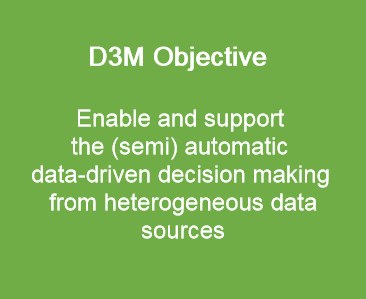D3M Objective
Nov 01, 2022
D3M aims to enable and support the (semi) automatic data-driven decision making from heterogeneous data sources.
The proposal of the project builds upon two research assets previously developed by our research teams:
- Generation and Evolution of Smart APIs (GENESIS),
- A dataspace management system (hereafter referred to as ODIN) and
- A software analytics tool (hereafter referred to as Strategic Dashboard).
The goal of the project is broke down into the following subobjectives:
O1: Data-driven semi-automatic bootstrapping. To provide means to enable an incremental semi-automatic extraction of the domain ontology from a set of heterogeneous and independent data sources.
O2: Integrated data exploration interface. To enable data wrangling tasks (navigational queries on tabular and semantic data) from heterogeneous data sources federated through a domain ontology.
O3: Customized decision making support. To enable the creation of an advanced dashboard that spans heterogeneous data sources, by applying domain-specific quality models in order to assist decision makers.
O4: Unified product to support the end-to-end decision making process over heterogeneous data sources. To integrate the results of O1-O3; i.e., features for incremental bootstrapping of the domain ontology and data sources, and its exploitation: decision-making support based on strategic indicators and data exploration based on data wrangling.
O5: Incremental technology transfer of the proof of concept. Execute a technology transfer plan to assure an incremental evolution of the maturity (TRL) level of the developed software components for D3M via validation and demonstration of the proposed proof-of-concept (use cases).
O6: Assessment of the viability of the proof of concept. Perform a market analysis to assess the technical, commercial, and social viability of the proposed product, and uncover evolutionary paths for D3M becoming a product adapted to current and anticipated industry needs.
O7: Long-term sustainability of the proof of concept. Cultivate a broad network of industry and public sector contacts for both creating awareness and attract prospective customers.
O8: Intellectual property right assurance. Develop a strategy for managing the intellectual and industrial property rights of the developed proof of concept.
O9: Endorsing the project team with entrepreneurship skills. Define a training plan with a list of entrepreneurship courses and monitor its execution.

Share: